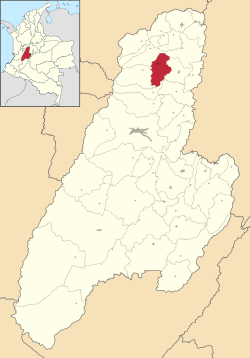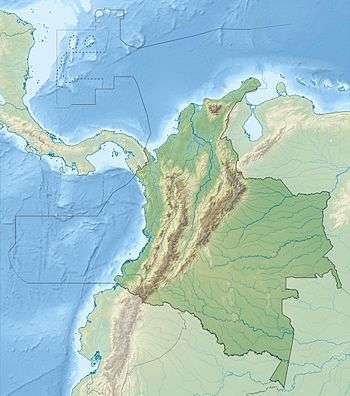Líbano, Tolima
Líbano is a town and municipality in the Tolima department of Colombia. The population of the municipality was estimated 39,459 as of 2020.[1] Along with Honda, Tolima, Líbano is the seat of the Roman Catholic Diocese of Líbano–Honda.
Líbano, Tolima | |
|---|---|
_1.jpg) aerial photo of Líbano. | |
.svg.png) Flag  Seal | |
 Location of the municipality and town of Líbano, Tolima in the Tolima Department of Colombia. | |
| Coordinates: 4°55′N 75°10′W | |
| Country | |
| Department | Tolima Department |
| Government | |
| • Alcalde (Mayor) | José Germán Castellanos Herrera |
| Area | |
| • Municipality | 299.44 km2 (115.61 sq mi) |
| • Urban | 3.28 km2 (1.27 sq mi) |
| Elevation | 1,565 m (5,135 ft) |
| Population (2020 est.[1]) | |
| • Municipality | 39,459 |
| • Density | 130/km2 (340/sq mi) |
| Time zone | UTC-5 (Colombia Standard Time) |
| Website | http://www.libano-tolima.gov.co |
History
Before the arrival of Europeans, the Panches, Pantagoras, Bledos, and Marquetones lived in the region. They were among the tribes most feared by the Muisca. Their society was an aristocratic hierarchy headed by a chief.
By the mid-nineteenth century, settlers from Antioquia explored south in search of vacant land, and mines, to be acquired by degrees of effort and incorporated into the national economy. A caravan of Antioqueños led by Isidro Parra, found a valley planted with cedars and oaks, and constructed a few huts. The hamlet was named Líbano, the Spanish word for Lebanon.
The layout of the built-up area of Líbano was organized as a village in 1886. Since 1900, Líbano developed as an important village, pushing dirt roads in all directions. Socio-economic development of the region was guided by its founders from the development of mining and power to the cultivation of coffee, which has become the main characteristic element of the economy, society and culture of the area.
The city of Líbano is the see of the Diocese of Líbano-Honda, created by Pope John Paul II on July 26, 1989 by the Bull "Ita Iam." The territorial area of the diocese covers an area of 3,477 km ² with approximately 240,000 inhabitants. Its first bishop was Monsignor José Luis Serna Alzate, who took office on October 7, 1989. On 5 December 2015, José Luis Henao Cadavid was installed as the fourth bishop of the diocese.
Geography
_Colombia_2a.jpg)
The municipality of Líbano is located in the north of the department of Tolima, about 56 kilometres (35 mi) north of Ibagué, the departmental capital. Líbano is bordered to the north by the municipalities of Armero and Villahermosa, to the West by the municipality of Murillo, to the East by the municipality of Lérida and to the south by Santa Isabel and Venadillo.
Líbano is located in the Cordillera Central, east of Nevado del Ruiz. The town is at an altitude of 1,565 metres (5,135 ft) above sea level, putting it in the tierra templada, or temperate zone, of Colombia. The area is hilly and heavily forested where it is not used for agriculture. Agriculture in the area includes growing of coffee, bananas, plantains, and beans.
References
- "Resultados y proyecciones (2005-2020) del censo 2005". Retrieved 17 April 2020.
